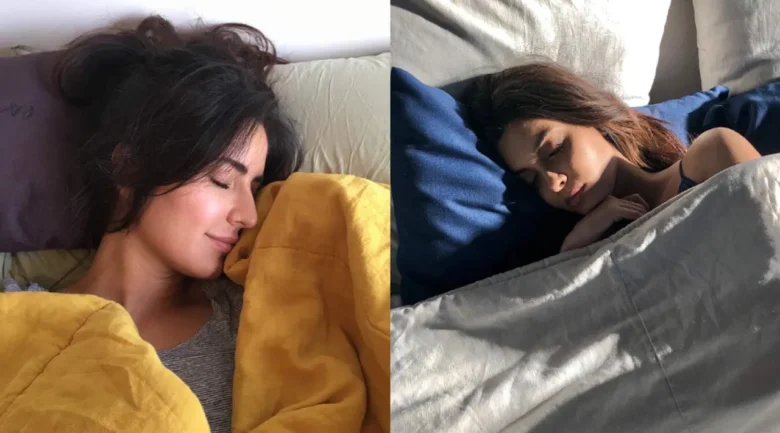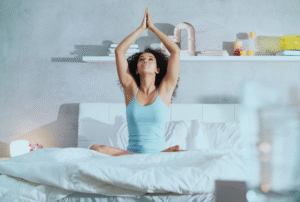Deep sleep (also called slow-wave sleep) is the most restorative phase of the sleeping cycle. Your heart rate and blood pressure decrease while brain waves become more deliberate.
If you are having difficulty sleeping or staying asleep, try these proven techniques to relax both mind and body.
1. Deep Breathing Exercises
Deep breathing exercises can help lower your heart rate, blood pressure, and relax muscles. Furthermore, oxygen therapy increases in your bloodstream which in turn provides stress and pain relief.
Practice relaxation techniques like these to promote better night’s rest. However, their effectiveness increases when combined with other measures that improve sleep such as healthy diet and consistent bedtime schedule.
Deep breathing can be practiced anytime of day or night, at work or at home. To start off, find a comfortable position to sit or lie down for several minutes while focusing on your breath, watching its rhythm as it expands and contracts your chest and abdomen. Inhale through the nose while relaxing your shoulders; exhale through mouth – purse your lips slightly upon exhale! Do this simple exercise for several minutes until it calms your mind and body – gradually increase how long this technique is practiced until eventually increasing it gradually over time.
2. NSDR
NSDR (non-sleep deep rest) is a relaxation technique proven to reduce stress and increase focus. Recently, it has seen increased interest after neuroscientist Andrew Huberman–who originated the term–featured it on popular podcasts featuring Tim Ferriss and Joe Rogan. Furthermore, many high-profile people such as Google CEO Sundar Pichai have endorsed its practice.
Like mindfulness and meditation, NSDR employs breathing, visualization and attention exercises to reduce activity in the sympathetic nervous system (which controls fight-or-flight responses) while stimulating parasympathetic activity (rest-and-relax responses). But unlike those practices, NSDR was specifically created not to induce sleep.
Get cozy on a comfy surface, put on some headphones, and listen to an NSDR podcast or audio recording. Instructions will lead you through various body parts as you relax them systematically. Done at the right time of day, it can be an invaluable way to reset and recharge. To improve sleep quality at nighttime, Winter advises scheduling sessions during the afternoon instead as that will give your body time to adapt.
3. Meditation
Meditation has been practiced for millennia and often associated with religion. But meditation can also be practiced independently without religious affiliation – find one that suits you today.
Mindfulness meditation is a popular form of meditation in which practitioners sit or lie comfortably and focus on breathing, gently bringing their attention back to it if their minds wanders off-track. Mindfulness can help reduce anxiety, ease pain and improve sleep; additionally, it has been known to decrease blood pressure and heart rate.
Other forms of meditation include guided imagery, which involves visualizing relaxing scenes and places in your mind, and body scanning – which combines breathing focus with progressive muscle relaxation – by starting at one area and tensing and relaxing it for several seconds before moving onto another one. Repeat until all parts of your body have felt relaxed – this process may also improve sleep as well as relieve headaches or stomachaches. Try these meditation techniques before bed or during the day to unwind mind and body alike!
4. Yoga
Yoga is an evidence-based physical and mental practice which has been shown to accelerate both how quickly a person falls asleep as well as deepen their slumber. This effect stems from its effect on the parasympathetic nervous system, which triggers its “rest and digest” mode to lower cortisol levels while slowing heart rate.
Asana (poses) and pranayama (yogic breathing) have also been proven to help alleviate anxiety and stress levels while simultaneously supporting healthy body image and self-esteem, something particularly crucial for people suffering from eating disorders.
As with any relaxation technique, meditation takes time and dedication to master. Finding one that suits you may take some trial-and-error. But once found, meditation can become an invaluable asset that helps you sleep more peacefully at night while feeling less stress during the day.
5. Music
Research confirms the efficacy of music to have an immediate and profound calming effect. Listening to soothing melodies can reduce anxiety, decrease heart rate and blood pressure levels, as well as decrease firing of neurons associated with fear (the amygdala).
If you’re having difficulty sleeping, try listening to soothing songs that you know well – perhaps those from your childhood! A familiar tune may help guide your subconscious into that state known as slow-wave sleep where deep relaxation takes place.
One effective method of relaxation is visualizing or thinking of a soothing scene that holds special meaning for you. Visualization techniques may involve scent, sound, touch and sight – this process is known as guided imagery and it can be practiced anywhere from meditation or yoga classes to simply imagining peaceful images in your mind’s eye.
A warm bath, cup of hot tea or coffee and other simple comforts can help break a cycle of stress, relax your mind and body and promote better restful sleep. Incorporating deep breathing exercises or tools such as progressive muscle relaxation or biofeedback to observe how thoughts, feelings, actions and movements influence heart rate, blood pressure, temperature or muscle tension is also helpful in breaking stress cycles and relaxing both mind and body.




